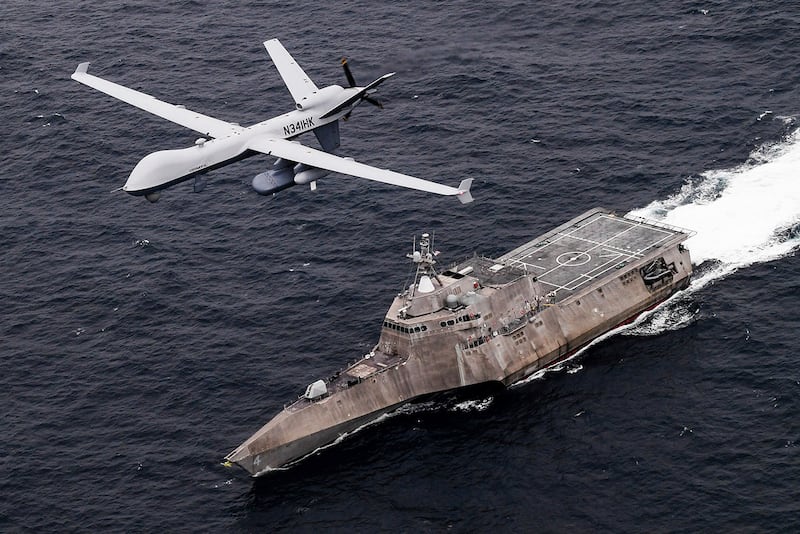The US Navy's Middle East-based 5th Fleet said on Wednesday it will launch a new task force that incorporates airborne, sailing and underwater drones after years of maritime attacks linked to continuing tension with Iran.
Navy officials declined to identify which systems they would introduce from their headquarters in Bahrain in the Arabian Gulf.
However, they promised in the coming months that the drones would stretch their capabilities across a region of chokepoints crucial to both global energy supplies and worldwide shipping.
“We want to put more systems out in the maritime domain above, on and below the sea,” said Vice Admiral Brad Cooper, who leads the 5th Fleet. “We want more eyes on what’s happening out there.”
The 5th Fleet includes the crucial Strait of Hormuz, the narrow mouth of the Arabian Gulf through which 20 per cent of all oil passes. It also stretches as far as the Red Sea near the Suez Canal, the waterway in Egypt linking the Middle East to the Mediterranean, and the Bab Al Mandeb Strait off Yemen.
The systems being used by the 5th Fleet’s new Task Force 59 will include some of those involved in an April test led by the navy’s Pacific Fleet.
Drones used in that exercise included ultra-endurance aerial surveillance drones, surface ships Sea Hawk and Sea Hunter as well as smaller underwater drones that resemble torpedoes.
The 5th Fleet includes shallow water areas, salty waters and temperatures in the summertime that can go above 45°C. That can prove rough for crewed vessels, let alone those running remotely.
“I think that environment really suits us well to experiment and move faster,” Vice Admiral Cooper said. “And our belief is if the new systems can work here, they can probably work anywhere else and can scale them across other fleets.”
It also represents a region that has seen a series of at-sea attacks in recent years.
Off Yemen, bomb-laden drone boats and mines set adrift by Yemen’s Houthi rebels have damaged vessels amid that country’s lengthy war.
Near the UAE and the Strait of Hormuz, oil tankers have been seized by Iranian forces.
Suspicious explosions have also hit vessels in the region, including tankers owned by western firms, ships tied to Israel and Iranian vessels.

These attacks have become part of a wider shadow war playing out across the region following then-president Donald Trump’s 2018 decision to unilaterally withdraw from Iran’s nuclear deal with world powers. Iran even shot down an American drone amid the tension.
While President Joe Biden has said he’s willing to re-enter the deal, negotiations in Vienna have stalled as Iran now has a new hard-line president.
That leaves open the possibility of further attacks by Iran — as well as by Israel, which has been suspected in attacks on Iranian shipping and sites linked to its nuclear programme.
Vice Admiral Cooper acknowledged the tension in his remarks to journalists on Wednesday, but declined to go into specifics.
“We’re very aware of Iran’s posture and we’ll be prepared to deal with that appropriately,” the vice admiral said. “I’m going to leave it at that.”
Iran’s mission to the UN did not immediately respond to a request for comment on the new US task force.
However, it operates its own drone fleet and has published video in the past of flyovers of American aircraft carriers in the region.
The US military has also said that fragments left following an attack in July off Oman that killed two people on an Israeli-linked ship corresponded to Iranian military drones.





